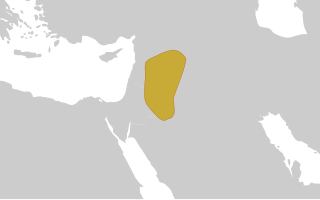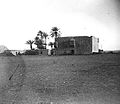
Al-Walid ibn Abd al-Malik ibn Marwan, commonly known as al-Walid I, was the sixth Umayyad caliph, ruling from October 705 until his death in 715. He was the eldest son of his predecessor, Caliph Abd al-Malik. As a prince, he led annual raids against the Byzantines from 695 to 698 and built or restored fortifications along the Syrian Desert route to Mecca. He became heir apparent in c. 705, after the death of the designated successor, Abd al-Malik's brother Abd al-Aziz ibn Marwan.
Hisham ibn Abd al-Malik ibn Marwan was the tenth Umayyad caliph, ruling from 724 until his death in 743.

The Ghassanids, also called the Jafnids, were an Arab tribe which founded a kingdom which was in place from the third century to the seventh century in the area of the Levant and northern Arabia. They emigrated from South Arabia in the early third century to the Levant. Some merged with Hellenized Christian communities, converting to Christianity in the first few centuries, while others may have already been Christians before emigrating north to escape religious persecution.
The Banu Lakhm was an Arab tribe best known for its ruling Nasrid, or more commonly, 'Lakhmid', house, which ruled as the Sasanian Empire's vassal kings in the buffer zone with the nomadic Arab tribes of northern and eastern Arabia.
The Banu Kalb was an Arab tribe which mainly dwelt in the desert and steppe of northwestern Arabia and central Syria. It was involved in the tribal politics of the Byzantine Empire's eastern frontiers, possibly as early as the 4th century. By the 6th century, the Kalb had largely adopted Christianity and came under the authority of the Ghassanids, leaders of the Byzantines' Arab allies. During the lifetime of the Islamic prophet Muhammad, a few of his close companions were Kalbites, most prominently Zayd ibn Haritha and Dihya, but the bulk of the tribe remained Christian at the time of Muhammad's death in 632. They began converting in large numbers when the Muslims made significant progress in the conquest of Byzantine Syria, in which the Kalb stayed neutral. As a massive nomadic tribe with considerable military experience, the Kalb was sought as a key ally by the Muslim state. The leading clans of the Kalb forged marital ties with the Umayyad family, and the tribe became the military foundation of the Syria-based Umayyad Caliphate (661–750) from the reign of Mu'awiya I to the early reign of Abd al-Malik.

The Kingdom of Kinda also called the Kindite kingdom, refers to the rule of the nomadic Arab tribes of the Ma'add confederation in north and central Arabia by the Banu Akil al-Murar, a family of the South Arabian tribe of Kinda, in c. 450 – c. 550 CE. The Kinda did not belong to the Ma'add and their rule over them was likely at the confederation's initiative and engineered by the Kinda's South Arabian patron, the Himyarite Kingdom. The tribes may have sought a prominent, non-involved leader to bring stability to the Ma'add during a period of constant feuding among its constituents.
The Battle of Daumat al-Jandal took place between Muslims and Rebel Arab tribes in August 633 CE. This was a part of the Riddah wars. Daumat al-Jandal was given to Iyad ibn Ghanm to crush the rebels, but he failed in doing so, and send for help to Khalid ibn Walid who was in Iraq in those days.
The Battle of Marj Rahit was a minor conflict fought between the Ghassanid Arab allies of Byzantine Empire and the Rashidun army under the command of Khalid bin Walid in April 634. The morning after the Battle of Huwwarin, Khalid moved his army of 9000 towards Damascus.

The Tayy, also known as Ṭayyi, Tayyaye, or Taiyaye, are a large and ancient Arab tribe, among whose descendants today are the tribes of Bani Sakher and Shammar. The nisba (patronymic) of Tayy is aṭ-Ṭāʾī (ٱلطَّائِي). In the second century CE, they migrated to the northern Arabian ranges of the Shammar and Salma Mountains, which then collectively became known as the Jabal Tayy, and later Jabal Shammar. The latter continues to be the traditional homeland of the tribe until the present day. They later established relations with the Sasanian and Byzantine empires.
Jurhum historically referred to as the Goramenoi in the 5th century, was a tribe of Arabia associated with Mecca. Muslim texts state that they were succeeded by Qusayy ibn Kilab, the leader of the Quraysh.
Deir Sharqi, historically called Dayr al-Naqira or Dayr Sim'an, is a village administratively belonging to the Idlib Governorate in northwestern Syria. Nearby localities include the mantiqah ("district") center of Maarrat al-Numan located 5 kilometres (3.1 mi) to the northwest, Maar Shamshah to the north, Maar Shamarin and Tell Mannas to the northeast, Jarjnaz to the east, al-Tah to the south, Hish to the southwest and Basqala, Hass and Kafr Nabl to the west. According to the Syria Central Bureau of Statistics, Deir Sharqi had a population of 4,429 in the 2004 census.
Yawm Halima is the name given to a battle fought between the rival Ghassanid and Lakhmid Arabs in the 6th century.
Jabiyah was a town of political and military significance in the 6th–8th centuries. It was located between the Hawran plain and the Golan Heights. It initially served as the capital of the Ghassanids, an Arab vassal kingdom of the Byzantine Empire. Following the Muslim conquest of Syria, it early on became the Muslims' main military camp in the region and, for a time, the capital of Jund Dimashq. Caliph Umar convened a meeting of senior Muslim figures at the city where the organization of Syria and military pay were decided. Later, in 684, Jabiyah was the site of a summit of Arab tribes that chose Marwan I to succeed Caliph Mu'awiya II. Jabiyah was often used by the Umayyad caliphs as a retreat. Its significance declined when Caliph Sulayman made Dabiq the Muslims' main military camp in Syria.
Banū al-Qayn were an Arab tribe that was active between the early Roman era in the Near East through the early Islamic era, as far as the historical record is concerned.

The Salīḥids, also known simply as Salīḥ or by their royal house, the Zokomids were the dominant Arab foederati of the Byzantine Empire in the 5th century. They succeeded the Tanukhids, who were dominant in the 4th century, and were in turn defeated and replaced by the Ghassanids in the early 6th century.
The Bahra' were an Arab tribe that inhabited the middle Euphrates valley around the trade center and Arab Christian holy city of Resafa during the late Byzantine era, and later the Homs region of central Syria during the Islamic era. After converting to Christianity, and becoming part of the Ghassanid-led tribal federates of the Byzantines in the late 6th century, the Bahra' were tasked with guarding Resafa. They were part of Byzantine–Arab coalitions against the nascent Arab Muslims in 629, 633 and 634, before ultimately converting to Islam after the Muslim conquest of Syria. In the following centuries they mostly inhabited central Syria, lending their name to the area's Jabal Bahra' range.

Udhruh, also spelled Adhruh, is a town in southern Jordan, administratively part of the Ma'an Governorate. It is located 15 kilometers (9.3 mi) east of Petra. It is the center of the Udhruh Subdistrict. In 2015, the town had a population of 1,700 and the subdistrict had a population of 8,374.
The Iyad were an Arab tribe which dwelt in western lower and upper Mesopotamia and northern Syria during the 3rd–7th centuries CE. Parts of the tribe adopted Christianity in the mid-3rd century and came under the suzerainty of the Lakhmid kings of al-Hirah, vassals of the Sasanian Empire. From that time, parts of the tribe settled in towns and villages along the Euphrates, while other parts remained nomadic and dwelt in the neighboring desert steppes. The Iyad played a significant role among the Arab tribes in the Fertile Crescent before the advent of Islam, as allies and opponents of the Sasanians and later allies of the Byzantine Empire. As the early Muslim conquests were underway, parts of the tribe in lower Mesopotamia embraced Islam, while those established in northern Syria and Upper Mesopotamia fled with the retreating Byzantine armies into Anatolia. They were expelled by Emperor Heraclius to Muslim territory after pressure by Caliph Umar. Little is heard of the tribe afterward, though a number of Iyad tribesmen served as qadis in different provinces of the Abbasid Caliphate in the 9th century and a family of the Iyad, that of Ibn Zuhr, grew prominent in Muslim Spain.
ʿUmar ibn al-Walīd ibn ʿAbd al-Malik was an Umayyad prince, commander in the Arab–Byzantine wars and the governor of Jund al-Urdunn during the reign of his father al-Walid I. He may have patronized the Umayyad desert palaces of Khirbat al-Minya in modern Israel and Qasr Kharana in modern Jordan.
The Kinda, or Kindah, were an Arab tribe from South Arabia.









